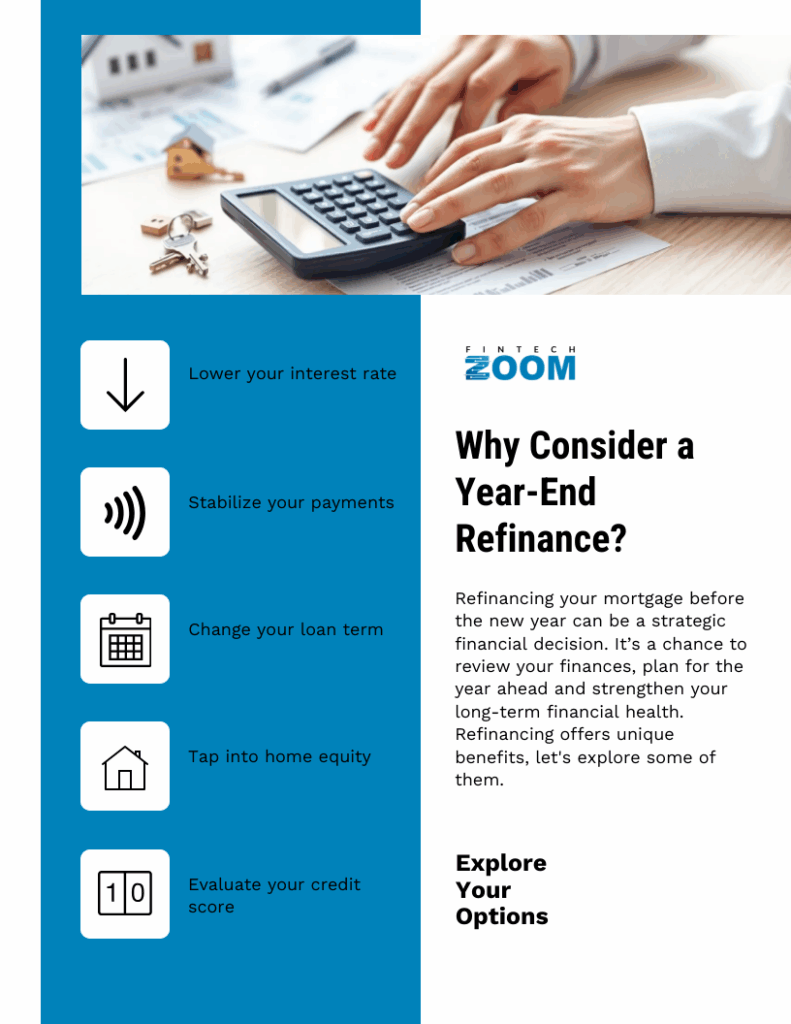Amid the holiday rush and gatherings with family and friends, the end of the year is also a great time to look ahead. For many homeowners, that includes taking a fresh view at their mortgage. Refinancing before the new year could mean locking in a lower rate, reducing monthly payments or using your home’s equity to reach new financial goals. This guide breaks down what to consider and how a year-end refinance could set you up for a stronger start next year.
Why Consider a Year-End Refinance?
Refinancing your mortgage before the new year can be a strategic financial decision. It’s a chance to review your finances, plan for the year ahead and strengthen your long-term financial health. Whether you’re considering a conventional loan refinance, a VA IRRRL Streamline Refinance, a cash-out refinance or another option, refinancing offers unique benefits. Let’s explore some of the main reasons to consider a year-end refinance.
Reaching Financial Goals
The end of the year is a natural time for reflection and planning. You might be reviewing your budget, checking your savings and planning major expenses like home upgrades, education costs or paying off your mortgage early.
Refinancing can be a powerful part of that process. Depending on your situation, it can help you:
- Lower your interest rate. Refinancing to a lower interest rate can reduce your monthly mortgage payment and the total amount you pay in interest over time.
- Stabilize your payments. Switching from an adjustable-rate mortgage to a fixed-rate loan can provide predictability and long-term peace of mind.
- Change your term. Shortening your loan term can help you pay off your mortgage faster, while extending it may lower your monthly payment and free up cash flow.
- Tap into equity. A cash-out refinance lets you access a portion of your home’s equity to fund large expenses or consolidate higher-interest debt.
Taking Advantage of Market Conditions
While interest rates are influenced by many complex factors, seasonal trends can sometimes play a role. The latter part of the year can see shifts in lender volume, which may influence the competitiveness of rates and terms offered.
Staying informed about current market conditions is key. FreddieMac reports that mortgage rates are continuing to trend down. So, if rates are favorable for your situation, acting before they potentially change in the new year could result in significant long-term savings.
What to Evaluate Before Refinancing
Before starting a refinance application, take a thorough look at your financial goals and current mortgage details. Are you hoping to lower your monthly payments, shorten your loan term or tap into your home’s equity? Understanding what you want to achieve—and how your existing loan compares—can help you decide whether refinancing is the right move and if you’re likely to qualify for favorable terms.
Your Current Interest Rate
One of the most common reasons to refinance is to secure a lower interest rate. Even a small drop can lead to meaningful savings over time.
Compare your current rate with those being offered today. As a general rule, if you can lower your rate by 0.75% to 1% or more, refinancing may make sense. However, even a smaller reduction can be worthwhile depending on your loan size and how long you plan to stay in your home.

Your Home Equity
Home equity is the difference between your home’s current market value and what you still owe on your mortgage. Rising property values in recent years have helped many homeowners build equity, which influences refinancing options.
- Traditional refinance: When you refinance with a traditional lender, you typically need at least 20% equity in your home to avoid private mortgage insurance (PMI). If you’re already at that level, you can usually refinance without PMI.
If you currently pay PMI and your home’s value has increased, refinancing could help you cross that 20% equity mark, allowing you to remove PMI and lower your monthly payment.
- Cash-out refinance: This option lets you borrow against your home’s equity and receive the difference in cash to fund projects like home improvements, education, or debt consolidation.
Your Credit Score
Your credit score influences the rate and terms you’ll qualify for. A higher score can lead to lower interest rates and better loan options.
Since your score is based on the information in your credit report, check your credit report before applying for a refinance. Review it for errors and make any necessary improvements, such as paying down revolving debt and ensuring all payments are made on time. You can request a free credit report at AnnualCreditReport.com.
Your Break-Even Point
Refinancing comes with closing costs—usually 2% to 5% of the loan amount. To see if refinancing makes financial sense, calculate your break-even point: Divide your total closing costs by your estimated monthly savings. For example, if closing costs are $5,000 and you save $200 a month, you’ll break even in 25 months ($5,000 ÷ $200). If you plan to stay in your home beyond that time, refinancing could be a smart move.
Understanding Your Refinancing Options
There are several types of refinance loans, each designed to meet different financial needs. Understanding these options will help you choose the one that best suits your goals.
Rate-and-Term Refinance
A rate-and-term refinance is the most common type of refinance. Its primary purpose is to change the interest rate, the loan term (the number of years you have to repay the loan) or both. Homeowners often use this option to:
- Lower their interest rate. This reduces the monthly payment and the total interest paid over the life of the loan.
- Shorten the loan term. Switching from a 30-year to a 15-year mortgage can help you pay off your home faster and save a significant amount on interest, though it will likely increase your monthly payment.
- Switch from an adjustable-rate mortgage (ARM) to a fixed-rate mortgage. This provides the stability of a consistent monthly payment that won’t change over time.
Cash-Out Refinance
A cash-out refinance allows you to tap into your home equity by replacing your current mortgage with a new, larger loan. You receive the difference between the two loan amounts as a lump sum of cash. This can be an excellent way to fund major expenses, such as:
- Home improvements or renovations
- Consolidating high-interest debt, like credit cards or personal loans
- Paying for college tuition or other educational expenses
- Covering unexpected medical bills
It is important to remember that a cash-out refinance increases your total mortgage debt, so it should be approached with careful consideration.

Streamline Refinance
A streamline refinance is designed to simplify and expedite the refinancing process for certain government-backed loans. These programs typically offer reduced paperwork and faster closings, making them an accessible option for eligible homeowners. Some of the main types of streamline refinances include:
- FHA Streamline Refinance: Available to homeowners with existing FHA home loans, an FHA Streamline Refinance often requires minimal documentation and no appraisal, and can result in a lower interest rate or reduced monthly payment.
- VA Interest Rate Reduction Refinance Loan (IRRRL): The VA IRRRL is offered to eligible veterans and active service members with VA loans. This program is focused on lowering interest rates and monthly payments with fewer verification requirements.
- USDA Streamlined Assist Refinance: Tailored to homeowners with USDA loans, this refinance provides a simplified application process, often without the need for a new appraisal or credit check.
Each program has its own eligibility requirements and benefits, so it’s important to review your loan type and financial goals to determine which option may best support your needs.
How to Prepare for Your Refinance
If you have decided that refinancing before the end of the year is the right step for you, taking a few preparatory measures can help ensure a smooth process.
- Define your goal. Be clear about what you want to achieve. Are you aiming for a lower monthly payment, a shorter loan term, or access to cash? Your goal will guide your choice of loan product.
- Gather your financial documents. Similar to home equity loan requirements, lenders will need to verify your income, assets and debts before approving your refinance. Start by collecting recent pay stubs, W-2s, tax returns and bank statements. Having these ready can help speed up the process. Streamline refinances generally have fewer documentation requirements, but it’s still smart to be prepared.
- Compare lenders. Don’t settle for the first offer you receive. Shop around and compare rates, fees and terms from multiple lenders. This will help you find the most competitive deal and ensure you’re making a well-informed decision.
H2: Should You Ring in the New Year With a Refi?
As you count down to the new year, why not count down to your next big money goal, too? Refinancing your mortgage could help you lower your rate, shorten your loan term or access extra cash for the milestones ahead. Take a little time now to explore your options and step into 2026 with confidence and a stronger financial footing.


